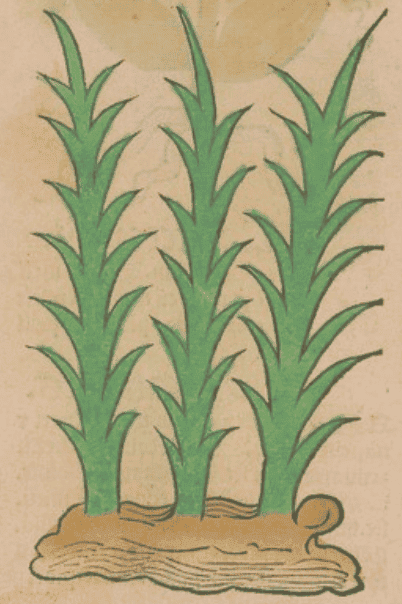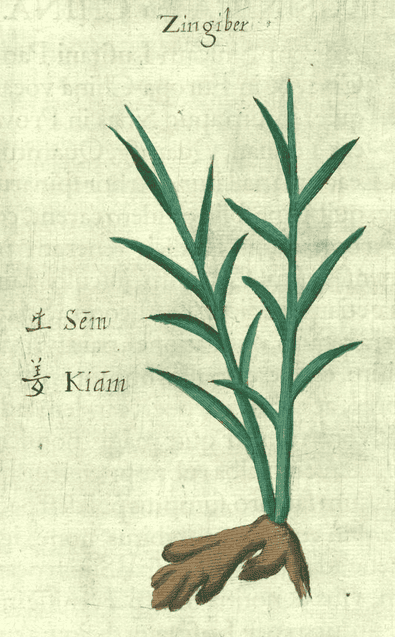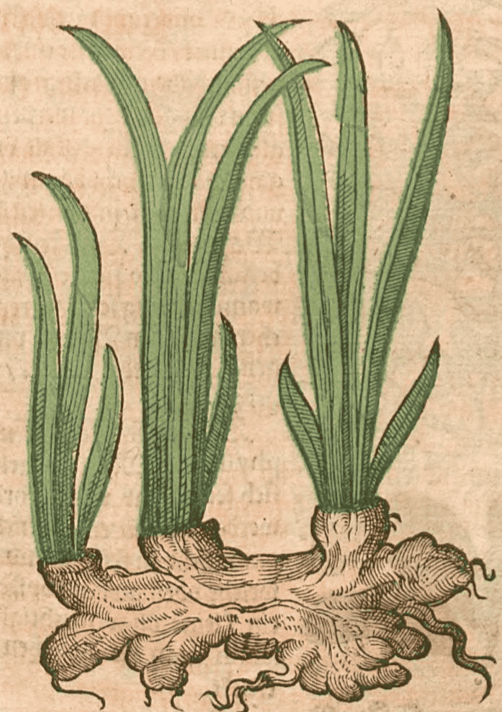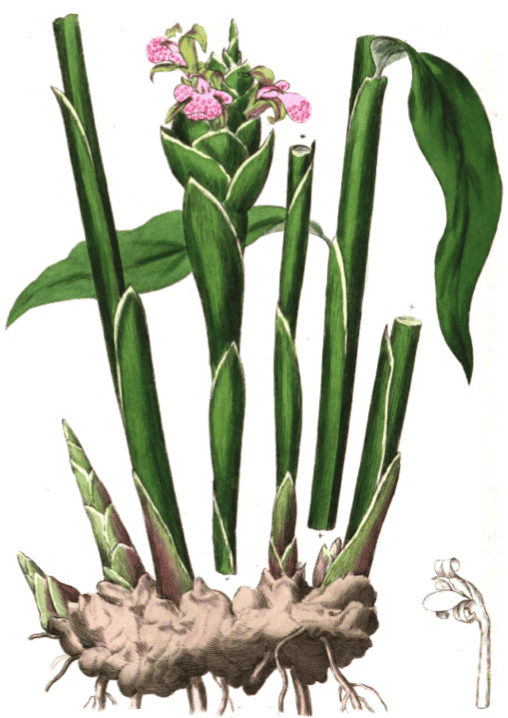Zinziberis Recens, Fresh Ginger, Sheng Jiang 生姜
Sheng Jiang (TCM)

|

|
|
Ortus Sanitatis, Meydenbach, 1491 |
Flora Sinensis, Boym, 1653 |

|

|
|
Krauterbuch, Lonitzer, 1578 |
Medical Botany, Woodville, Hooker, 1832 |
 Members CLICK HERE for the PRO VERSION
Members CLICK HERE for the PRO VERSIONBotanical name:
Zingiber officinalis
Parts used:
Fresh Rhizome
Temperature & Taste:
Warm, dry. Pungent, Sweet.
Classifications:
TCM:
A. Clear Exterior Wind-Cold O. Promotes Digestion
Uses:
1. Clears Wind-Cold, Promotes Sweat: (West, TCM Ayurveda, Tibetan)
-used for cold types of common cold or flu with thin white sputum, and cold symptoms. (dried root is also used).
2. Warms the Stomach, Stops Vomiting: (West, TCM Ayurveda, Tibetan)
-vomiting, nausea and abdominal pain; used for various abdominal problems from cold, including Morning Sickness.
3. Warms the Lungs, Stops Cough: (West, TCM Ayurveda, Tibetan)
-both acute and chronic cold-type cough and phlegm.
-Cold type chest pain.
4. Harmonises the Exterior:
-spontaneous Sweating associated with weakness or disharmony of the external defense Qi (Wei Qi). (TCM)
5. Clears Toxins, Resists Poison (West, TCM Ayurveda, Tibetan):
-various plant and food poisoning; Fresh Ginger can neutralise Aconite (it is often decocted with, or prepared using Ginger)
-Similarly, it was said to be ‘a corrective of many medicines’ (Barham 1794).
-Fish and Crab poisoning etc (TCM, West); in Fiji, it is used for poisoning from the Red Parrot Fish.
-Ginger was also chewed when visiting the sick to prevent infection.
Dose:
Fresh Ginger in decoction: 3–6 slices (5–10 grams);
Of the Juice: 5–10 mls. The juice taken with Honey balances excess of all Humors.
Comment:
… available in PRO version
Correctives:
… available in PRO version
Substitute:
… available in PRO version
Preparation:
… available in PRO version

Main Combinations:
Ginger and Jujube/Red Date (Da Zao)
To regulate and strengthen the Stomach, for Nausea, Vomiting, stomach Pain, and to relieve side effects of toxic or hard-to-digest medicines, often used with Chinese Red Dates (Da Zao).
1. Ginger Pills: Combine Ginger … available in PRO version
2. Acute Cold or Flu from Wind-Cold:
i. fresh Ginger with … available in PRO version
3. Cold Phlegm:
i. Fresh Ginger with … available in PRO version
4. Poor digestion, Nausea, Vomiting
i. Fresh Ginger, … available in PRO version
ii. Fresh Ginger, … available in PRO version
5. To warm and strengthen the Stomach:
i. Fresh Ginger with … available in PRO version
ii. Fresh Ginger, … available in PRO version
iii. Candied Ginger, … available in PRO version
6. Morning Sickness, Fresh Ginger with … available in PRO version
7. Dysmenorrhea, fresh Ginger … available in PRO version
8. Scoliosis and crookedness of the Spine, Confected Ginger with … available in PRO version
Major Formulas:
Ban Xia Bai Zhu Tian Ma Tang
Ban Xia Hou Po Tang
Chai Hu Gui Zhi Tang
Da Chi Hu Tang
Da Qing Long Tang
Dao Tan Tang
Fang Ji Huang Qi Tang
Ge Gan Jia Ban Xia Tang
Ge Gan Tang
Gui Pi Tang
Gui Zhi Jia Fu Zi Tang
Gui Zhi Jia Long Gu Mu Li Tang
Gui Zhi Jia Shao Yao Tang
Gui Zhi Shao Yao Zhi Mu Tang
Gui Zhi Tang
Huang Lian Wen Dan Tang
Huo Xiang Zheng Qi San
Juan Bi Tang
Ma Huang Lian Qiao Chi Xiao Dao Tang
Mu Xiang Bing Lang Wan
Ping Wei San
Qing Fei Tang
Ren Shen Bai Du San
Ren Shen Yang Rong Tang
Wen Dan Tang
Wu Hu Tang
Wu Pi San
Xiang Sha Liu Jun Zi Tang
Xiao Chai Hu Tang
Yan Hu Suo Tang
Zhen Wu Tang
Zhi Gan Cao Tang
Zhi Zi Sheng Jiang Chi Tang
Cautions:
1. Spontaneous Sweating from exterior deficiency.
2. Heat including Heat from Yin deficiency.
3. Avoid high doses with Hypertension.
Main Preparations used:
Candied Ginger, Green Ginger
-
Extra Info
- History
|
‘Ginger is known in India under the old name of Sringavera, derived possibly from the Greek [?]. As a spice it was used among the Greeks and Romans, who appear to have received it by way of the Red Sea, inasmuch as they considered it to be a production of Southern Arabia. In the list of imports from the Red Sea into Alexandria, which in the second century of our era were there liable to the Roman fiscal duty (vectigal), Zingiber occurs among other Indian spices. During the middle ages it is frequently mentioned in similar lists, and evidently constituted an important item in the commercial relations between Europe and the East. Ginger thus appears in the tariff of duties levied at Acre in Palestine about A.D. 1173; in that of Barcelona in 1221; Marseilles in 1228; and Paris in 1290. The Tarif des Peages, or customs tariff, of the Counts of Provence in the middle of the 13th century, provides for the levying of duty at the towns of Aix, Digne, Valensole, Tarascon, Avignon, Orgon, Aries, &c, on various commodities imported from the East. These included spices, as pepper, ginger, cloves, zedoary, galangal, cubebs, saffron, canella, cumin, anise; dye stuffs, such as lac, indigo, Brazil wood, and especially alum from Castilia and Volcano; and groceries, as racalicia (liquorice), sugar and dates. In England ginger must have been tolerably well known even prior to the Norman Conquest, for it is frequently named in the Anglo- Saxon leech-books of the 11th century, as well as in the Welsh “Physicians of Myddvai“. During the 13th and 14th centuries it was, next to pepper, the commonest of spices, costing on an average nearly 1s. 7d. per lb., or about the price of a sheep. |
The merchants of Italy,about the middle of the 14th century, knew three kinds of ginger, called respectively Belledi, Colombino, and Micchino. These terms may be explained thus:–Belledi or Baladi is an Arabic word, which, as applied to ginger, would signify country or wild, i.e. common ginger. Colombino refers to Columbum, Kolamor Quilon, a port in Travancore frequently mentioned in the middle ages. Ginger termed Micchino denotes that the spice had been brought from or by way of Mecca. Ginger preserved in syrup, and sometimes called Green Ginger, was also imported during the middle ages, and regarded as a delicacy of the choicest kind. The plant affording ginger must have been known to Marco Polo (circa 1280-90), who speaks of observing it both in China and India. John of Montecorvino, who visited India about 1292, describes ginger as a plant like a flag, the root of which can be dug up and transported. Nicolo Conti also gave some description of the plant and of the collection of the root, as witnessed by him in India. The Venetians received ginger by way of Egypt; yet some of the superior kinds were conveyed from India overland by the Black Sea, as stated by Marino Sanudo about 1306. Ginger was introduced into America by Francisco de Mendoca, who took it from the East Indies to New Spain. It was shipped for commercial purposes from the Island of St. Domingo as early at least as 1585; and from Barbados in 1654. According to Renny, 22,053 cwt. were exported from the West Indies to Spain in 1547. (Pharmacographia, Fluckiger & Hanbury, 1879) |
